- Clone
- E13-161.7 (See other available formats)
- Regulatory Status
- RUO
- Other Names
- Sca-1
- Isotype
- Rat IgG2a, κ
- Ave. Rating
- Submit a Review
- Product Citations
- publications

-

C57BL/6 mouse splenocytes stained with biotinylated E13-161.7, followed by Sav-PE
| Cat # | Size | Price | Quantity Check Availability | Save | ||
|---|---|---|---|---|---|---|
| 122504 | 500 µg | $262 | ||||
Ly-6A/E is an 18 kD member of the Ly-6 multigene family also known as Sca-1. Ly6A/E is a glycosylphosphatidylinositol (GPI)-linked protein expressed on hematopoietic stem cells. In mice expressing the Ly-6.2 haplotype (e.g., AKR, C57BL, C57BR, DBA/2, SJL, SWR, and 129), Ly-6A/E is also expressed on peripheral B lymphocytes and thymic and peripheral T lymphocytes. Strains expressing the Ly-6.1 haplotype (e.g., BALB/c, CBA, C3H/He, DBA/1, and NZB) have low Ly-6A/E expression on resting peripheral lymphocytes. The expression of Ly-6A/E on lymphocytes is upregulated upon activation from both Ly6.1 and Ly6.2 haplotype mice. Ly-6A/E is thought to be involved in the regulation of both T and B cell responses. The E13-161.7 antibody has been reported to be useful for immunohistochemical staining of frozen sections, immunoprecipitation, flow cytometry, and complement-mediated cytotoxicity.
Product DetailsProduct Details
- Verified Reactivity
- Mouse
- Antibody Type
- Monoclonal
- Host Species
- Rat
- Immunogen
- mouse pre-T cells
- Formulation
- Phosphate-buffered solution, pH 7.2, containing 0.09% sodium azide.
- Preparation
- The antibody was purified by affinity chromatography, and conjugated with biotin under optimal conditions.
- Concentration
- 0.5 mg/ml
- Storage & Handling
- The antibody solution should be stored undiluted between 2°C and 8°C. Do not freeze.
- Application
-
FC - Quality tested
- Recommended Usage
-
Each lot of this antibody is quality control tested by immunofluorescent staining with flow cytometric analysis. For flow cytometric staining, the suggested use of this reagent is ≤ 0.25 µg per 106 cells in 100 µl volume. It is recommended that the reagent be titrated for optimal performance for each application.
- Application Notes
-
Additional reported applications (for the relevant formats) include: complement-mediated cytoxicity1, immunohistochemical staining of frozen sections2 and Bouin-fixed, paraffin-embedded samples4, immunofluorescence microscopy4, and immunoprecipitation3.
The two Sca-1 recognizing clones D7 and E13-161.7 have been shown to bind distinct epitopes due to the inability of D7 to block the binding of E13-161.7.7 -
Application References
(PubMed link indicates BioLegend citation) -
- Aihara Y, et al. 1986. Eur. J. Immunol. 16:1391. (CMCD)
- Spangrude GJ, et al. 1988. J. Immunol. 141:3697. (IHC)
- van de Rijin M, et al. 1989. P. Natl. Acad. Sci. USA 86:4634. (IP)
- van Bragt MPA, et al. 2005. Biol. Reprod. 73:634. (IHC, IF)
- Rosas M, et al. 2010. J. Leukoc. Biol. 88:169. PubMed
- Felthause O, et al. 2010. Neurosci Lett. 471:179. PubMed
- Bamezai A and Rock KL. 1995. Proc. Natl. Acad. Sci. USA 92:4294.
- Product Citations
-
- RRID
-
AB_756189 (BioLegend Cat. No. 122504)
Antigen Details
- Structure
- Ly-6 multigene family, 18 kD
- Distribution
-
Hematopoietic stem cells, activated T cells and B cells, subset of resting B cells and T cells
- Function
- Regulates B and T cell responses
- Cell Type
- B cells, Hematopoietic stem and progenitors, Mesenchymal Stem Cells, T cells
- Biology Area
- Immunology, Stem Cells
- Antigen References
-
1. Rock KL, et al. 1989. Immunol. Rev. 111:195.
2. Morrison SJ, et al. 1994. Immunity 1:661.
3. Spangrude GJ, et al. 1988. J. Immunol. 141:3697.
4. Malek T, et al. 1986. J. Exp. Med. 164:709. - Gene ID
- 110454 View all products for this Gene ID
- UniProt
- View information about Ly-6A/E on UniProt.org
Related Pages & Pathways
Pages
Related FAQs
- How many biotin molecules are per antibody structure?
- We don't routinely measure the number of biotins with our antibody products but the number of biotin molecules range from 3-6 molecules per antibody.
Other Formats
View All Ly-6A/E Reagents Request Custom Conjugation| Description | Clone | Applications |
|---|---|---|
| Purified anti-mouse Ly-6A/E (Sca-1) | E13-161.7 | FC,IHC-F,IHC-P,IP |
| Biotin anti-mouse Ly-6A/E (Sca-1) | E13-161.7 | FC |
| FITC anti-mouse Ly-6A/E (Sca-1) | E13-161.7 | FC |
| PE anti-mouse Ly-6A/E (Sca-1) | E13-161.7 | FC |
| APC anti-mouse Ly-6A/E (Sca-1) | E13-161.7 | FC |
| PE/Cyanine7 anti-mouse Ly-6A/E (Sca-1) | E13-161.7 | FC |
| Alexa Fluor® 488 anti-mouse Ly-6A/E (Sca-1) | E13-161.7 | FC |
| Alexa Fluor® 647 anti-mouse Ly-6A/E (Sca-1) | E13-161.7 | FC |
| Pacific Blue™ anti-mouse Ly-6A/E (Sca-1) | E13-161.7 | FC |
| PerCP/Cyanine5.5 anti-mouse Ly-6A/E (Sca-1) | E13-161.7 | FC |
| APC/Fire™ 750 anti-mouse Ly-6A/E (Sca-1) | E13-161.7 | FC |
| PE/Dazzle™ 594 anti-mouse Ly-6A/E (Sca-1) | E13-161.7 | FC |
Customers Also Purchased
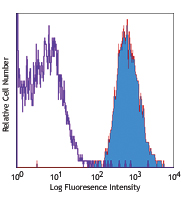
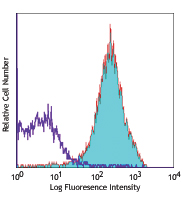
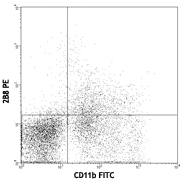
Compare Data Across All Formats
This data display is provided for general comparisons between formats.
Your actual data may vary due to variations in samples, target cells, instruments and their settings, staining conditions, and other factors.
If you need assistance with selecting the best format contact our expert technical support team.
-
Purified anti-mouse Ly-6A/E (Sca-1)

C57BL/6 mouse splenocytes stained with purified E13-161.7, f... -
Biotin anti-mouse Ly-6A/E (Sca-1)
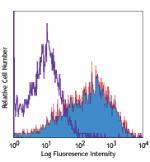
C57BL/6 mouse splenocytes stained with biotinylated E13-161.... -
FITC anti-mouse Ly-6A/E (Sca-1)

C57BL/6 mouse splenocytes stained with E13-161.7 FITC -
PE anti-mouse Ly-6A/E (Sca-1)
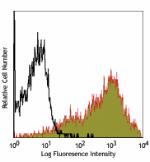
C57BL/6 mouse splenocytes stained with E13-161.7 PE -
APC anti-mouse Ly-6A/E (Sca-1)

C57BL6 splenocytes stained with E13-161.7 APC -
PE/Cyanine7 anti-mouse Ly-6A/E (Sca-1)

C57BL/6 mouse splenocytes stained with E13-161.7 PE/Cyanine7 -
Alexa Fluor® 488 anti-mouse Ly-6A/E (Sca-1)

C57BL/6 splenocytes stained with E13-161.7 Alexa Fluor® 488 -
Alexa Fluor® 647 anti-mouse Ly-6A/E (Sca-1)
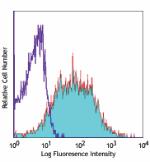
C57BL/6 mouse splenocytes stained with E13-161.7 Alexa Fluor... -
Pacific Blue™ anti-mouse Ly-6A/E (Sca-1)
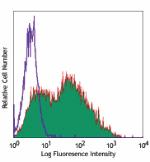
C57BL/6 mouse splenocytes stained with Pacific Blue™ E... -
PerCP/Cyanine5.5 anti-mouse Ly-6A/E (Sca-1)
-
APC/Fire™ 750 anti-mouse Ly-6A/E (Sca-1)

C57BL/6 mouse splenocytes were stained with Ly-6A/E (clone E... -
PE/Dazzle™ 594 anti-mouse Ly-6A/E (Sca-1)

C57BL/6 mouse splenocytes were stained with Ly-6A/E (clone E...
 Login/Register
Login/Register 






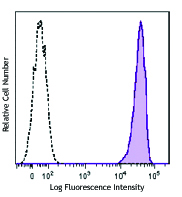



Follow Us